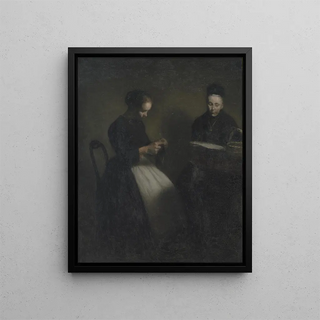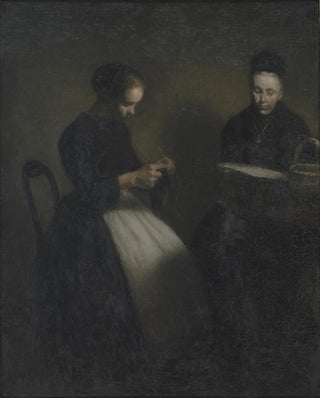Art print | Evening at the artist's salon Mother and wife - Vilhelm Hammershøi


View from behind

Frame (optional)
The scene unfolds with rare delicacy, an intimate atmosphere where time seems to stand still. "Art print Soirée au salon La mère et l'épouse de l'artiste - Vilhelm Hammershøi" transports us into a universe imbued with melancholy and serenity. This painting, emblematic of the symbolist movement, evokes a domestic ambiance, where light plays a central role, enveloping the female figures with a soft and soothing aura. The characters, though silent, appear filled with stories and thoughts, inviting the viewer to delve into their inner world. The skillfully orchestrated composition by Hammershøi encourages reflection on solitude, memory, and family bonds, while celebrating the beauty of the present moment.
Style and uniqueness of the work
Hammershøi's style is distinguished by its minimalist approach and subtle color palette. In "Art print Soirée au salon," the gentle shades of gray, beige, and white create a visual harmony that calms the mind. The clean lines and geometric shapes demonstrate remarkable technical mastery, while the interplay of light and shadow adds an almost poetic dimension to the piece. The female figures, though present, are often depicted in a way that makes them seem almost ethereal, as if they are an integral part of the surrounding space. This fusion between the characters and their environment highlights the artist's quest to capture the essence of everyday life, while emphasizing the beauty of often overlooked details. Hammershøi succeeds in creating an atmosphere where each element, from furniture to wall textures, contributes to the overall harmony of the scene.
The artist and his influence
Vilhelm Hammershøi, an emblematic figure of early 20th-century Danish art, established himself through his unique style and poetic vision. Influenced by the old masters and contemporary currents of his time, he developed a singular approach that blends intimacy and abstraction. Hammershøi often drew inspiration from his immediate environment, notably

Matte finish

View from behind

Frame (optional)
The scene unfolds with rare delicacy, an intimate atmosphere where time seems to stand still. "Art print Soirée au salon La mère et l'épouse de l'artiste - Vilhelm Hammershøi" transports us into a universe imbued with melancholy and serenity. This painting, emblematic of the symbolist movement, evokes a domestic ambiance, where light plays a central role, enveloping the female figures with a soft and soothing aura. The characters, though silent, appear filled with stories and thoughts, inviting the viewer to delve into their inner world. The skillfully orchestrated composition by Hammershøi encourages reflection on solitude, memory, and family bonds, while celebrating the beauty of the present moment.
Style and uniqueness of the work
Hammershøi's style is distinguished by its minimalist approach and subtle color palette. In "Art print Soirée au salon," the gentle shades of gray, beige, and white create a visual harmony that calms the mind. The clean lines and geometric shapes demonstrate remarkable technical mastery, while the interplay of light and shadow adds an almost poetic dimension to the piece. The female figures, though present, are often depicted in a way that makes them seem almost ethereal, as if they are an integral part of the surrounding space. This fusion between the characters and their environment highlights the artist's quest to capture the essence of everyday life, while emphasizing the beauty of often overlooked details. Hammershøi succeeds in creating an atmosphere where each element, from furniture to wall textures, contributes to the overall harmony of the scene.
The artist and his influence
Vilhelm Hammershøi, an emblematic figure of early 20th-century Danish art, established himself through his unique style and poetic vision. Influenced by the old masters and contemporary currents of his time, he developed a singular approach that blends intimacy and abstraction. Hammershøi often drew inspiration from his immediate environment, notably






